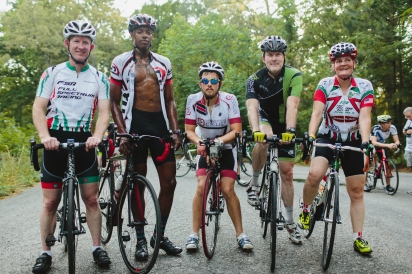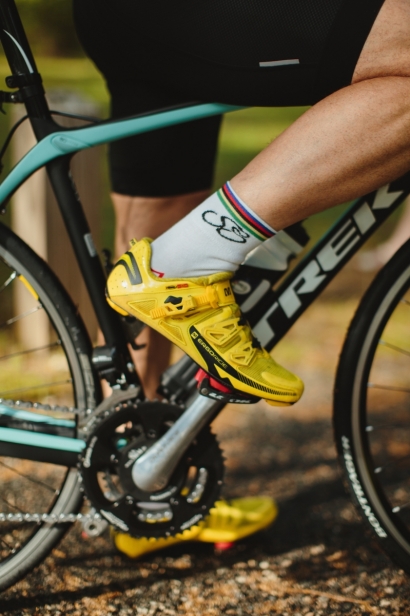Skratch Labs Founder Allen Lim Explains How to Eat and Run
When Taylor Phinney races in the professional cycling peloton, he’s one of the Americans who is usually fueled by one of Allen Lim’s rice cakes. Lim, PhD, is a sports physiologist, founder of Boulder-based Skratch Labs and cookbook co-author with chef Biju Thomas.
For the past seven years, Lim has worked to develop ways to fight cycling’s doping culture. He was instrumental in developing a method of testing for biological markers of performance-enhancing drugs, and he also transformed the professional peloton with his “real food” approach to sports nutrition.
In advance of Lim’s visit to Richmond for the 2015 World Cycling Championships in September, Edible Richmond talked with him about his three diet rules, when you should eat during a long workout and the importance of a good rice cooker.
Edible Richmond: Your degree is in integrative physiology. How did you get involved in sports nutrition?
Allen Lim: After I got my PhD from the University of Colorado I got hired to go off to the pro cycling tour to help a cyclist named Floyd Landis. I went on the pro tour for the summer of 2005 [the year before Landis won the Tour de France and was found guilty of doping].
It was a total shit show. Not just the doping but how these guys took care of themselves. I thought I was hired to be a sports scientist but what I realized was that sports science wasn’t the bottleneck, it was that the riders didn’t have the capacity and life skills to take care of themselves. Doping was really just the tip of the iceberg.
After that, I realized that the fix was to groom a group of really young Americans to start over and teach them life skills for being athletes and people. My focus became a three-legged stool: nutrition/hydration, training, sleep/recovery. Of those three, the leg they were least prepared to cope with was nutrition.
Q: Aren’t athletes usually very particular and smart about nutrition? Why were these riders struggling?
A: It’s one thing to understand what you are supposed to do, it’s another to take time to buy groceries and prepare a nice meal. You have to understand, most of these riders are 18 to 20 years old, it’s their first time away from home and they haven’t learned to cook. So they’re eating prepackaged food. We think about sport being healthy, but the nutrition marketed to athletes is garbage.
These young guys ask, “What do I eat?” And I say, “What’s in your fridge?” They say, “Nothing.” So I say, “Let’s go to the store and see what you like to eat.”
I taught this one kid how to boil pasta. He was totally amazed at how easy it was. He had some eggs and pasta sauce, so we did two eggs over easy and a little tomato sauce on the pasta. It was a fine meal for a kid who just finished a four-hour bike ride. Three weeks later I got an email from his roommate saying, “Dude, you have to come back over and teach us something else. The only dish Mike makes is this pasta-egg thing.”
Q: How did you get started actually cooking for cyclists?
A: We had one race in 2006 when I took these kids to a stage race in Ireland. Our shipment of energy bars was lost in transit. We didn’t have anything the guys could eat while on the bike, racing. So I went to the local market and started looking around. I bought some little new potatoes and asked the kitchen staff to boil them up. I cut them in half, dressed them with olive oil, salt and parmesan cheese, and wrapped them in parchment-paper-foil wrap. The guys loved it, they felt great. That began this whole idea of making real food, little portables for these guys.
I started making sushi rice bars with bacon and eggs, berries, coconut, whatever we could find locally. The team started traveling with a rice cooker and utensils, basically a kitchen. I found that when we relied heavily on protein drinks, gels and energy bars, most athletes complained of gastro-intestinal problems. Irritable bowel syndrome was a standard-issue thing. When we made food from scratch the riders ended up doing a lot better.
Now we have a 20-foot kitchen trailer that we take all over the country. We do all the food for the Tour of California. Biju flies in ahead of time and works with local hotels and caterers to plan menus, then we oversee that process on-site. On a typical race morning we make 1,000 rice bars and 250–400 cookie bars, all from scratch.
Q: What are your key guidelines for nutrition during long workouts?
A: Workouts aren’t a war. If you need to stop and have something to eat, stop and have something to eat. Sit down, eat your cookies, then finish the ride.
The purpose of eating and hydrating is to maintain blood sugar. So, if it’s an hour workout and you’ve missed lunch, yes, bring something to eat when you start exercising. But if you are doing a good job with your diet, for a one- to two-hour workout you probably just need hydration from a 4% carb sports drink. You get enough calories to sustain the activity with your ample stores of glycogen and fat. If you are trying to burn calories, don’t eat anything and make sure you are hydrated.
For a longer workout, food matters. Energy gels are like mainlining glucose. When you fast track that, you are pushing in food at a faster rate than your small intestine can absorb. Water shifts inside the body to the small intestine to dilute the food. Endurance athletes have a high degree of GI distress and diarrhea for that very reason.
The human body is really smart. When you eat solid food with a high moisture and moderate fiber content and chew it, the food holds in the stomach longer. Normal digestion allows for a consistent trickling of fuel into the small intestine at a pace it can absorb. There’s no traffic jam blocking everything up.
Q: So, how do you feel about those popular athlete diets like Paleo or low-carbohydrate?
A: Diets are all trend, all fashion. It’s like saying there’s one type of clothing or jacket for all body types. My first rule on diets and eating is, if you’re hungry, eat. If you aren’t, don’t. That’s a rule everyone breaks.
My second rule is that everyone has an intuitive sense of what foods make them feel bad. Don’t eat those foods.
The third rule is to make a list of foods that make you feel great. When my athletes are honest, they say something like, “This food makes me feel great, but my mom makes it and I don’t have the time.” If they can figure out how to get over that, they’re golden.
Q: You have talked about food helping build community, how does that work?
A: What I saw on the pro cycling tour was that when the riders were alone they fell apart. They were isolated and missing home. We needed to form a community to survive in Europe while we trained our butts off.
I started to think about it. Maybe the problem with the American diet isn’t the foods we eat, maybe it’s that we are eating in our cars or over the sink, and we’re missing something by not sharing with others. Food is culture. When we have a culture of isolation rather than a culture of sharing, everything starts to fall apart.
We ended up starting this whole revolution within the pro peloton of cooking from scratch, preparing all the meals and having oversight, and using fresh, real ingredients. It was our way of combatting the drugs and doping culture, and not just that we could provide better ingredients and foods, but a better overall environment. When you are in the middle of a Grand Tour and you see the team that’s laughing the most, having fun, sharing and communing around the table, that’s us.







